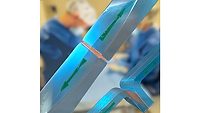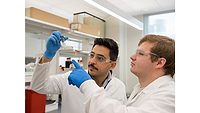Researchers Develop Adhesive for Potential Coral Reef Restoration

QUT researchers working to develop an adhesive for potential coral reef restoration. From left to right: Adrian Baker; Dr. Nathan Boase; Professor Leonie Barner; Professor Scott Bryan; Brett Lewis; Dr Lalehvash Moghaddam. Courtesy of QUT.
Queensland University of Technology (QUT) researchers are developing an underwater adhesive gel using plant waste and investigating ways of using it on coral reefs to accelerate the natural stabilization process and reef recovery.
The two-pronged project funded by the Reef Restoration and Adaptation Program (RRAP), involves researchers from the QUT School of Chemistry and Physics who have developed the gel-like adhesive, and researchers from the School of Earth and Atmospheric Sciences who are conducting laboratory tests to determine the most effective method for gluing underwater coral rubble as well as live coral fragments.
Professor Leonie Barner, leading the team developing the adhesive of Dr. Lalehvash Moghaddam, Adrian Baker, and Dr. Nathan Boase, said the project evolved out of a workshop she attended where the challenge was to develop a product that could be used in wide-scale restoration projects on the Great Barrier Reef. “This adhesive ticks a lot of boxes – it’s biocompatible, biodegradable, and it is scalable,” said Barner. “Now we need to test it on the reef.”
The QUT researchers have been putting the adhesive through laboratory tests, including use on a ceramic coral device. They have been experimenting using their adhesive to attach small cement tiles with young corals that slot into the device and are attached using the adhesive, with the aim to distribute to the young corals as part of reef re-seeding efforts. After the coral has time to grow over the ceramic device, the adhesive naturally breaks down without damaging the ecosystem.
While the chemistry team is now planning the first small-scale reef trial with the ceramic devices, other QUT researchers are looking at how the adhesive could be used to help the reef recover from damaging events that produce unstable coral rubble.
Rubble stabilization techniques are needed allow new corals to attach, regrow, and restore the coral reef after being detached due to natural disasters, ship groundings, or dynamite fishing.
Professor Scott Bryan and postdoctoral researcher Brett Lewis said the adhesive is being used to mimic various marine organisms that, over time, naturally bind and stabilize coral rubble. The adhesive is being studied to adhere pieces of coral rubble to form more stable masses that can accelerate the natural reef recovery process.
“The challenges are that with climate change and the potential for an increasing frequency of bleaching events and cyclones in the future, that when coral reefs are damaged, they won’t have the time to naturally regenerate and recuperate before the next damaging event,” said Bryan.
Lewis said the adhesive could be a solution to target coral rubble in areas of high importance and high degradation and encourage the regrowth by gluing and holding together coral rubble.
Currently, methods to rehabilitate coral rubble include adding metal, plastic, or concrete structures to the pristine reef, while the QUT-developed adhesive can hold coral pieces together while the coral regrows. It is environmentally friendly, and the adhesive will dissolve after a few years leaving no impact on the reef.
Bryan and Lewis are currently trialing methods to determine the best ways of using the adhesive underwater in lab tanks as a precursor to larger-scale field trials. But even at this stage, the researchers are thinking ahead. “In the future, restoration will likely need to be at larger scale and sustainable – restoration activities that need fleets of boats and lots of divers will be too expensive,” said Bryan.
To learn more, visit www.qut.edu.au.
Looking for a reprint of this article?
From high-res PDFs to custom plaques, order your copy today!





